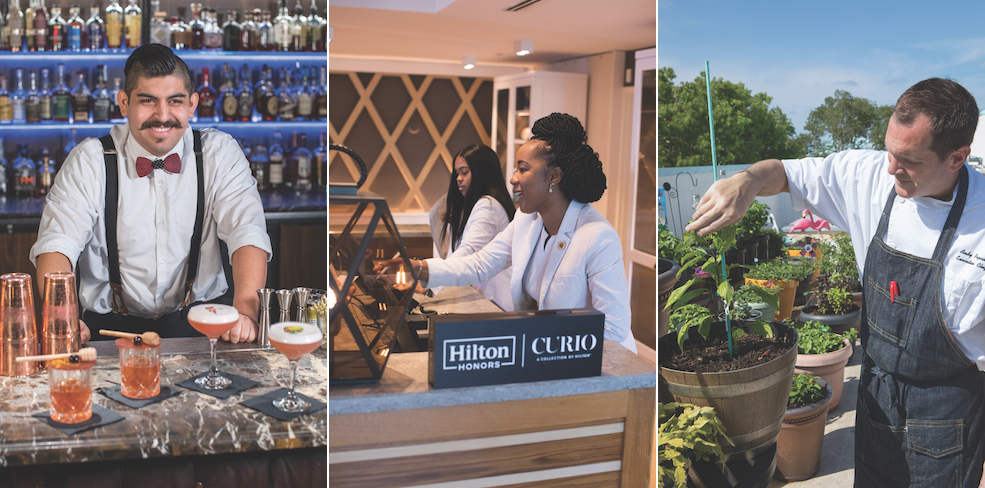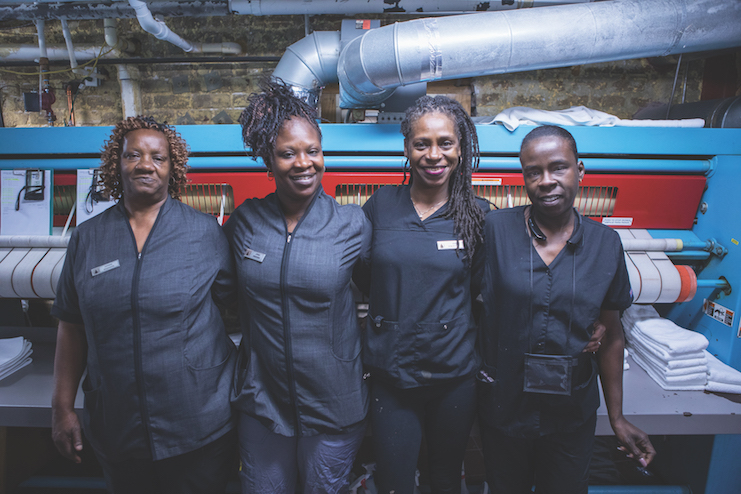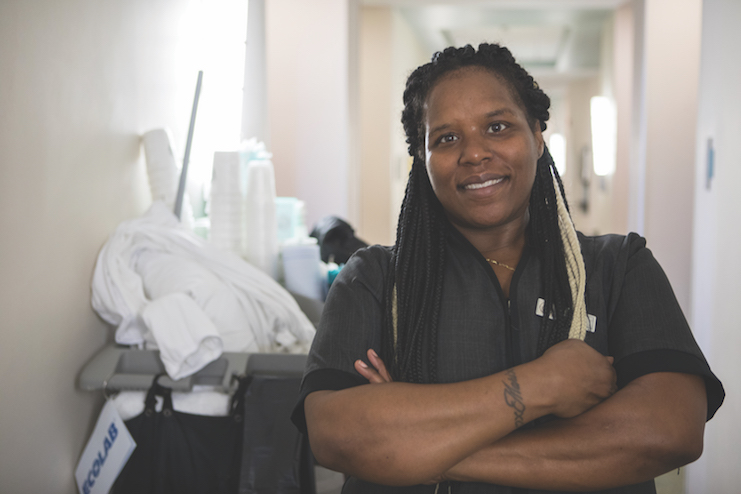As Hilton marks its 100th anniversary year, LODGING spoke to Chief Human Resources Officer Matthew Schuyler about how founder Conrad Hilton’s description of the core Hilton Hotel experience—“We’re in the business of people serving people.”—has informed its attitude toward guests and team members alike, leading to the success and longevity of this hospitality giant, which now has nearly 5,900 properties comprising more than 939,000 rooms in 114 countries and territories, and more than 410,000 team members.
On his watch, Schuyler saw Hilton recognized for its exceptional workplace culture, earning the #1 ranking on the 2019 Fortune Best Companies to Work For in the U.S. list. This recognition has served as a welcome “talent magnet” that places Hilton at an advantage in the currently intense competition for team members. However, Schuyler says the company’s focus on service, commitment to cultivating a positive culture, and developing programs that support team members’ health, growth, and happiness are longstanding and will continue regardless.

Building a Positive Workplace Culture
Schuyler and Laura Fuentes, who recently assumed a new Chief Talent Officer role, credit Hilton’s exceptional workplace culture for its top spot on the Fortune list, but say the culture it hailed was nothing new. “Being number one is a big achievement and we’re all really proud and humbled, but we were doing the work behind it for years without recognition because of the feedback we received from our team members,” says Schuyler.
Schuyler also says that Conrad Hilton’s words were always a mantra of sorts, but notes a conscious effort was made to create an organization-wide culture after the private equity firm Blackstone purchased Hilton Hotels Corporation in 2007. “One of the first things our CEO Chris Nassetta did then was set a new strategy with four strategic pillars—the first of which was to align our culture throughout the organization.” Given the different components at the time, he says, it was a challenge. “There were many efforts to achieve a culture at a local property level and at our corporate office level, but everyone was so different.”
He says the first step in achieving an all-pervasive culture was to set a single vision, mission, and set of values that would permeate the entire organization. What they came up with was a simple overarching cultural definition reflecting Hilton values, which are literally H-I-L-T-O-N—Hospitality, Integrity, Leadership, Teamwork, Ownership, and Now. This simple approach, he says, has been highly effective. “We now have 99 percent recognition of our vision, mission, and values. Those values are the language of our company now. We use them to recruit and develop, formulate training, and evaluate each other.”
A Team-Centric Environment
Guided by these values, Fuentes is responsible for the strategy and execution of core HR programs—including recruitment, leadership development, diversity and inclusions, benefits, compensation, and recognition—across the globe. She notes that handling this function for a global hospitality company gives her the opportunity to connect with people from different cultures all over the world, to help them reach their potential, and learn what matters to them in terms of issues such as healthcare, learning, and work/life balance. She maintains that Hilton’s special and unique culture is most of all focused on “doing the right thing for all.”

She says it’s the team members—more than 410,000 of them—doing different jobs under Hilton flags for various brands in over 100 countries that deliver the Hilton standard of service, and that it’s her job to support their ability to do and be their best. “We always want to make sure we have the right people in the right roles at the right time and that we’re allowing them to reach their full potential. My team and I are laser focused on creating the very best environment and culture for our team members, so they can focus their energy and passion and apply their service mindset to our guests.”
“We have a very tenured workforce. Once you’re with Hilton for a few years, you stick around. It’s not uncommon to bump into people with 40, 45, or even 50 years of experience.”
Bringing on the Competition for Talent
Schuyler says Hilton’s recognition as a desirable place to work was especially welcome, coming as it did during a period of intense competition for talent in an especially tight labor market. He says fortunately for Hilton, its team members have long known what the Fortune list publicized—that Hilton is a great place to work. “We have a very tenured workforce. Once you’re with Hilton for a few years, you stick around. It’s not uncommon to bump into people with 40, 45, or even 50 years of experience.”
Still, he says, given projected company growth and even the highest level of retention, the company needs to do all it can to forge ahead in its recruitment efforts. “With thousands of hotels in the pipeline, we’ll literally add hundreds of thousands more team members over these next three, four, five years. We know that consistency, reliability, and friendliness matter to our guests, so while we can leverage technology to some extent to improve our operations and support guest technology expectations, human resources are our most important resource.” Therefore, he says, growing their workforce is critical.

Fuentes agrees. She points to a “halo effect” from the Fortune list publicity that aids recruitment, and says she and her team aim to amplify it. “We do want to make people aware of our culture and the fact that it was our team members who voted that Hilton was a great place to work.”
But reaching prospective team members—and doing it quickly and efficiently—she says, is the name of the game in the currently competitive recruiting environment, saying, “We’re trying to set the pace, not just keep up with the pace.”
They are doing this, she explains with the help of modernized approaches to some aspects of attracting and retaining talent, using technology to help scale— not remove—the human element. This includes an enhanced recruiting engine that allows candidates to quickly filter through and gain access to the jobs that are relevant to them, and a career site that allows for intuitive navigation and application to specific jobs and customization by region. It also includes innovative uses of artificial intelligence (AI), explains Fuentes. “We’re investing in AI-based resume screening to help filter and triage which resumes are the most applicable to which jobs.” She describes an other-worldly way AI is even used for training. “We hire so many people at such a high volume—including people from other industries—so we want to make sure they can very quickly experience what it feels like to work on a property. Using virtual reality business immersion, they can put on their goggles and experience a day in the life of a team member at a property. It’s fun, but it’s helpful.”
Thriving at Hilton
An important part of employee satisfaction—and retention—Schuyler says, is recognizing and supporting their personal and professional goals. Thrive at Hilton—their Team Member value proposition which was created in partnership with Arianna Huffington’s Thrive Global—serves as the overarching umbrella under which its many “people programs” are covered.
“Thrive was launched to create an extraordinary culture where the talent is mobilized and achieving its goal potential. It’s our promise to team members that at Hilton, they can reach their full potential—they will develop and grow and flourish with us,” explains Schuyler, adding, “We have a history of investing differentially, going above and beyond what our industry might dictate because of our values and what matters to our team members.”

Schuyler observes that listening to team members is the best way to learn how to meet their needs now and determine what they will need in the future as the world of work and hospitality evolve. Among the programs under that umbrella that go above and beyond, he says, are Hilton’s industry- leading parental leave and adoption assistance, team member travel perks, and enhanced continuing education and career development programs.
He describes Thrive Sabbatical: Give a Dream, Live a Dream, which gives 10 team members four weeks of paid sabbatical time and $5,000 to pursue a passion. Now in its third year, this sabbatical enabled Mira Macud, a single mother and administrative assistant at the Conrad Dubai, to return to her home country of the Philippines, where she was sending money for the care of her deaf son. While there, she learned American Sign Language so she could communicate with her son, and also built a relationship with the team at the Conrad Manila, who offered her a position at the property. Other recipients include: Tim Sachse, Concierge at Hilton Berlin, who rented a wheelchair-accessible RV to take his father through the countryside of Sweden and Norway; Bronwyn Hartney, sales manager at Hilton Cobham, who trained a client for the 2019 Special Olympics in Abu Dhabi; and Emille Artigas, Marketing and PR Director at Hilton Doha, who organized an underwater dive trip with Project Aware – Dive Against Debris to survey and clean up ocean debris.
Commenting on the already-competitive parental leave program, Schuyler says, “We wanted to offer team members who are looking to welcome a child into their family a benefit that lives up to our value of hospitality, so we created an industry-leading adoption assistance program that provides team members with a $10,000 contribution to offset the many costs associated with adopting.”
He says Hilton’s travel program, which allows team members to stay at Hilton properties around the world at deeply discounted rates, has been enhanced in honor of Hilton’s 100th anniversary. “We were already giving team members 60 discounted nights—30 at team member rates and another 30 at friends and family rates—but for this occasion, we spread the wealth a little further, and gave them a total of 100 nights to use and share.” This benefit, he says, is available for life to all team members who have spent 10 or more years with the company, and gives those who have spent time in military service credit for that time toward the 10 years.

Schuyler mentions two additional initiatives designed to win hearts and minds of current and future team members. In response to team members’ feedback, he says, Hilton provided them a “wardrobe change”—innovative uniforms from Under Armour that are more in line with what they prefer to wear in their personal lives in terms of comfort and appearance, and are also more versatile, with customized designs including more breathable fabrics for physical roles or in hot locations. In addition, Hilton has invested millions of dollars revamping the back of house, or what they call Heart of House, to provide workers with a place that is as welcoming as a hotel’s public areas to kick back and relax. “These are comfortable places with things like locker rooms and flat screen TVs, where team members can put their feet up, grab a healthy bite to eat, chat with their colleagues, and recharge.” He says this initiative implemented mainly in newer properties has passed the 1,000-hotel mark and has already made a difference. “Engagement at those properties has gone up, morale has gone up, trust in the organization has gone up, and most importantly, customer service scores have gone up.”
“Creating a fabulous place to work is a significant business advantage that benefits everyone.”
The Dividends
Creating an environment that is inclusive, respectful, and responsive to team members’ needs, says Fuentes, is truly a win-win for everyone. “This type of environment energizes them, and they, in turn, energize our guests. The bottom line for the company is that creating a fabulous place to work is a significant business advantage that benefits everyone—franchise owners, the company, and team members.”
To make sure owners know it’s in their interests to be onboard with the Hilton culture, Fuentes says, her team generates supportive data. “We show how efforts to promote a positive culture reduce turnover, which reduces costs related to recruiting and training—so dollars can transfer back to the bottom line. We make them aware that more engaged team members are a source of innovation, productivity, and product optimization that saves money and allows for differential growth over time.”

What’s So Great About Hospitality
Schuyler, who has been with Hilton for 10 years now, says his professional life has been “blessed” in the people and companies he’s worked for—including the Pittsburgh Pirates—but says Hilton is his favorite workplace. “This is because of the people that make up this business. Among those team members working under Hilton flags around the world, there are more than 410,000 amazing stories of dedicating themselves to serving guests. It’s a massively cool industry, and a really cool place to do HR work,” he says.
Fuentes, who says she was inspired by Conrad Hilton’s vision of promoting world peace through travel, and who herself loves to travel, says she enjoys doing human resources in an industry that promotes human contact. “I think of hotels as vehicles to bring people together in an ever-more-divided world full of misunderstandings and silos; we have the product that will bring people together, one that literally offers spaces to connect.”
What’s Ahead
Schuyler says that celebrating Hilton’s 100th anniversary—in combination with the Fortune listing—has created a lot of excitement about the future, which he expects to be even better.
“We’re humbled to be getting the accolades we’re getting, but we’re not resting on our laurels,” Schuyler says. “We’ll continue to do more by listening to the needs of the workforce, not just as workers in hospitality and at Hilton, but as humans in this crazy world we live in.”












